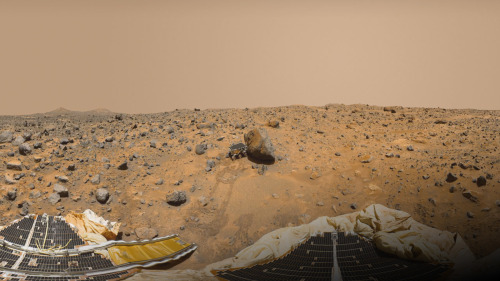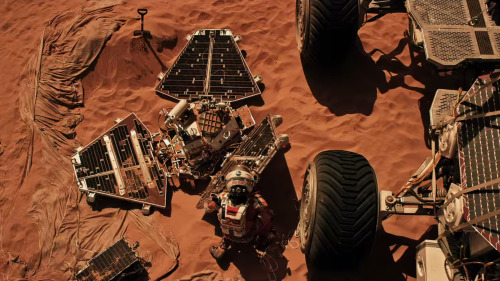Crazy Facts About The #YearInSpace
Crazy Facts About the #YearInSpace
Astronaut Scott Kelly and Russian cosmonaut Mikhail Kornienko returned from their One-Year Mission on March 1. When you spend a year doing anything, you’re bound to accumulate some crazy stats. Here are a few:

During their year in space, Kelly and Kornienko traveled over 143 million miles, conducting research to prepare us for our journey to Mars, which will be about 140,000,000 miles from Earth.

The International Space Station travels at a speed of 5 miles per second and orbits the Earth every 90 minutes.

These visiting vehicles brought food, supplies, experiments and more crew members to the space station.

Since the space station is orbiting the Earth at 17,500 miles per hour, the crew onboard sees 16 sunrises and sunsets each day.

Water is a precious and limited resource in space, so crew members recycle it whenever possible. That includes recycling their own urine.
Make sure to follow us on Tumblr for your regular dose of space: http://nasa.tumblr.com
More Posts from Darggga-blog and Others

The moon in the morning sky
Today marks 30 years since the world watched in horror as space shuttle Challenger broke apart on live TV just 73 seconds after takeoff. Seven crewmembers were killed, including high school teacher Christa McAuliffe, who had been selected as the first civilian to fly into space.






Almost a month ago, the spaceflight company Blue Origin sent a rocket up to the edge of space and then guided it gracefully back down to earth, intact. It was a historic first.
But Blue Origin’s major competitor, SpaceX, was quick to point out that the rocket wasn’t going fast enough (or sideways enough) to place a satellite into orbit - just 4,600 kph (~2,860 mph). It went straight up, and then straight down.
Now, SpaceX has managed to put 11 satellites in orbit with a “reusable” rocket. Their rocket didn’t just go up and down - it reached a horizontal velocity of 6,000 kph (3,600 mph) before returning to earth. If SpaceX is able to refurbish the rocket and use it in another launch, they’ll have figured out a way to dramatically reduce the cost of spaceflight.
Here’s the full webcast. And here’s the full story.
Video credit: SpaceX
The European Space Agency’s Sentinel-3 satellite, launched this week, is seen crossing the sky not long after launch with a jettisoned rocket stage right behind it, all amidst the beautiful northern lights display in northern Finland.
Breathtaking.


Mars Pathfinder & Sojourner Rover (360 View) Explained
Thanks to new technology, we can take a 360-degree tour of the 1997 Pathfinder mission landing site, including Sojourner, the first Mars rover. Check out this interactive YouTube panorama, and then…
…keep scrolling to find out more about each point of interest, how the Pathfinder mission compares to “The Martian” and NASA’s real Journey to Mars.

Yogi
“Yogi” is a meter-size rock about 5 meters northwest of the Mars Pathfinder lander and the second rock visited by the Sojourner Rover’s alpha proton X-ray spectrometer (APXS) instrument. This mosaic shows super resolution techniques applied to help to address questions about the texture of this rock and what it might tell us about how it came to be.

Twin Peaks
The Twin Peaks are modest-size hills to the southwest of the Mars Pathfinder landing site. They were discovered on the first panoramas taken by the IMP camera on the July 4, 1997, and subsequently identified in Viking Orbiter images taken over 20 years ago. They’re about 30-35 meters tall.

Barnacle Bill
“Barnacle Bill” is a small rock immediately west-northwest of the Mars Pathfinder lander and was the first rock visited by the Sojourner Rover’s alpha proton X-ray spectrometer (APXS) instrument. If you have some old-school red-cyan glasses, put them on and see this pic in eye-popping 3-D.

Rock Garden
The Rock Garden is a cluster of large, angular rocks tilted in a downstream direction from ancient floods on Mars. The rocky surface is comprised of materials washed down from the highlands and deposited in this ancient outflow channel.

MOAR INFO
Pathfinder Lander & Sojourner Rover
Mission Facts [PDF]
Science Results
Rock & Soil Types


This vista was stitched together from many images taken in 1997 by Pathfinder.

Pathfinder and Sojourner figure into Mark Watney’s quest for survival on the Red Planet in the book and movie, “The Martian.” See JPL’s role in making “The Martian” a reality: http://go.nasa.gov/1McRrXw and discover nine real NASA technologies depicted in “The Martian”: http://go.nasa.gov/1QiyUiC.

So what about the real-life “Journey to Mars”? NASA is developing the capabilities needed to send humans to Mars in the 2030s. Discover more at http://nasa.gov/journeytomars and don’t forget to visit me when you make it to the Red Planet. Until then, stay curious and I’ll see you online.
https://en.m.wikipedia.org/wiki/Apollo_1
Today is the anniversary of Apollo 1' accident. January 27, 1967 three astronauts gave their lifes for development of space travel. Virgil I. "Gus" Grissom, Edward H. White II, and Robert B. Chaffee - the bravest men in the world. Thank you for your sacrifice. Rest in peace, Guys!
What You Didn’t Know About Scott Kelly and Living in Space (Floating Urine is Involved)
First Ever NASA Reddit AMA from Space Recap

NASA astronaut Scott Kelly hosted a Reddit Ask Me Anything on Jan. 23 where people, well, asked him anything.
Kelly answered a range of questions from whether the crew members play space pranks on one another (“Occasionally…” Kelly said without elaboration.) to whether Kelly’s recovery plan will be different than normal (“I think my rehab plan is the same as if I were here for 6 months, but I’m not positive.”).
To start off, here are a few quick facts we learned about Kelly during the AMA:
The advice he would’ve given himself before going into space on day 1 would be to pack lighter.
His favorite David Bowie song is “Modern Love,” and his favorite non-space related movie is “The Godfather."
He uses a Nikon D4 when taking pictures (camera settings and lenses vary).
He thought it was cool to watch the movie "Gravity” while he was on the space station, because that’s where the movie took place.
Once he lands, Kelly will miss the challenge of being aboard the space station the most.
Here are a few fun questions that astronaut Scott Kelly answered:
What’s the creepiest thing you’ve encountered while on the job?

Could a rogue spaceship sneak up on the space station?

We finally got an answer for one thing so many of you have been curious about…why does Scott Kelly always fold his arms?


When astronauts go up to space, they experience something very few others have and see Earth from a very unique perspective. What’s one thing Kelly will do differently once he returns home?

Kelly also told one user something unusual about being in space that people normally don’t think about: feet calluses.

Another user wanted to know what the largest societal misconception about space/space travel is. According to Kelly, it has nothing to do with science.



To read the entire Reddit AMA with Kelly, visit his IAmA thread.
Kelly’s #YearInSpace ends Mar. 2. Follow him until the end of the journey (and beyond) on Twitter, Instagram and Facebook.
Make sure to follow us on Tumblr for your regular dose of space: http://nasa.tumblr.com

Solar System by Breath Art

I Got Humans

Apollo 11 astronaut Buzz Aldrin on the Moon with Neil Armstrong refected in the visor, July 20, 1969. (Florida Memory)
-
 hotdesert-50-blog liked this · 8 years ago
hotdesert-50-blog liked this · 8 years ago -
 michaelcosio reblogged this · 8 years ago
michaelcosio reblogged this · 8 years ago -
 insert-comic-book-quote-here liked this · 9 years ago
insert-comic-book-quote-here liked this · 9 years ago -
 insert-comic-book-quote-here reblogged this · 9 years ago
insert-comic-book-quote-here reblogged this · 9 years ago -
 dillonshepherd liked this · 9 years ago
dillonshepherd liked this · 9 years ago -
 who-is-this-prussian liked this · 9 years ago
who-is-this-prussian liked this · 9 years ago -
 xeroxink reblogged this · 9 years ago
xeroxink reblogged this · 9 years ago -
 jullzal-blog liked this · 9 years ago
jullzal-blog liked this · 9 years ago -
 hotvalencia liked this · 9 years ago
hotvalencia liked this · 9 years ago -
 jsbustaman liked this · 9 years ago
jsbustaman liked this · 9 years ago -
 rohschliff reblogged this · 9 years ago
rohschliff reblogged this · 9 years ago -
 gray-warden reblogged this · 9 years ago
gray-warden reblogged this · 9 years ago -
 tofucasserole liked this · 9 years ago
tofucasserole liked this · 9 years ago -
 anakingskywoker reblogged this · 9 years ago
anakingskywoker reblogged this · 9 years ago -
 finally-opened-up reblogged this · 9 years ago
finally-opened-up reblogged this · 9 years ago -
 aaresiv reblogged this · 9 years ago
aaresiv reblogged this · 9 years ago -
 scumbum6 liked this · 9 years ago
scumbum6 liked this · 9 years ago
'Your bones are made of the same dust as the planets (... ) You are full of the world'
28 posts